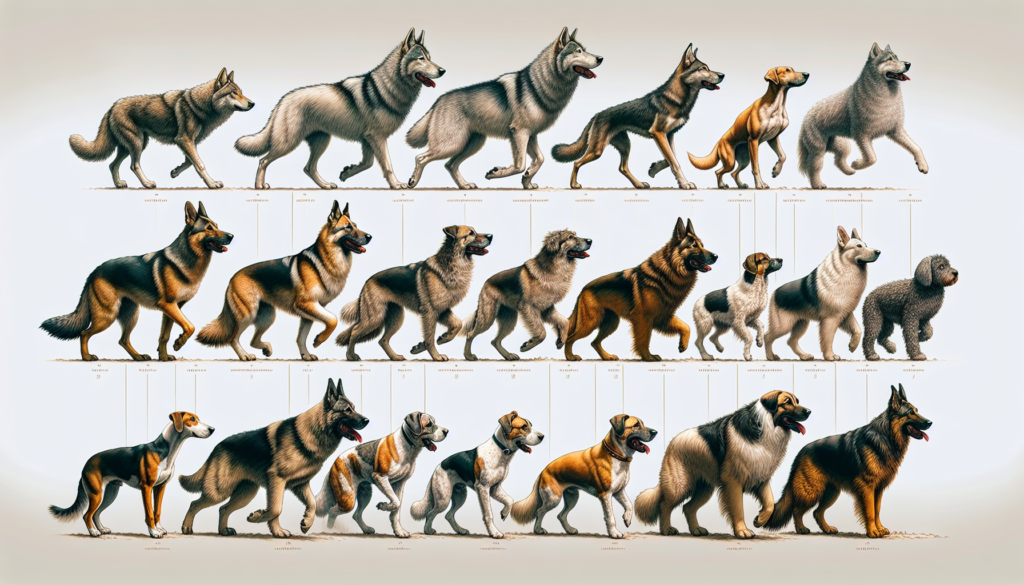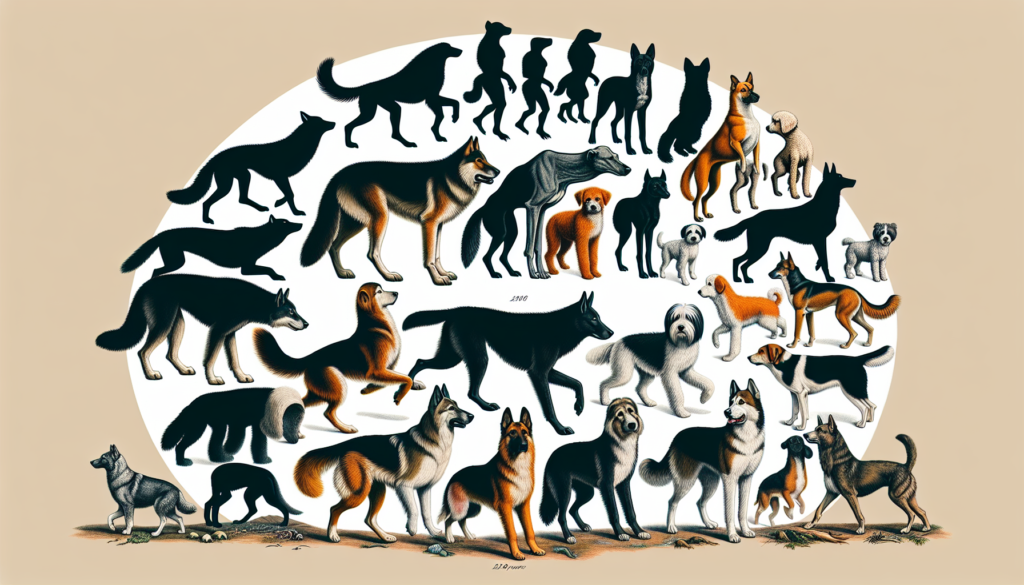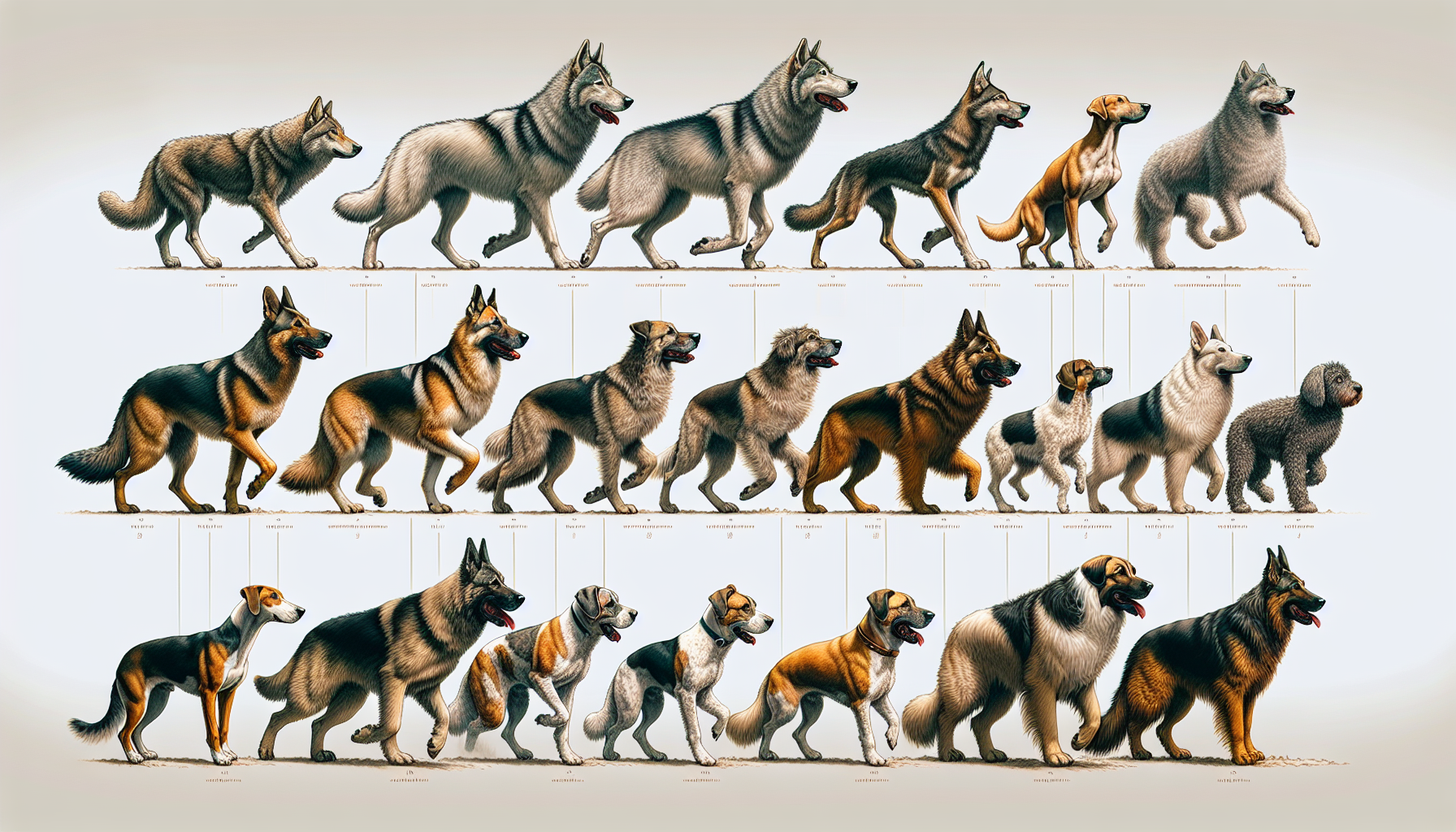Imagine stepping back in time and witnessing the fascinating journey of dog breeds. From their humble beginnings as wolves to the incredible diversity we see today, the evolution of dog breeds over time is a captivating tale. Through centuries of selective breeding, humans have shaped these loyal companions into an astonishing array of shapes, sizes, and temperaments. Join us as we explore the fascinating story behind the evolution of dog breeds and marvel at the extraordinary transformations that have taken place throughout history.

An Overview of Dog Domestication and Early Breeding Practices
Origins of Dog Domestication
The domestication of dogs is believed to have begun around 15,000 years ago. The exact origins of dog domestication remain a subject of debate among researchers, but it is widely accepted that wolves, the ancestors of domestic dogs, were selectively bred for their behavioral traits and skills that were advantageous to early human societies.
Early Roles of Dogs in Human Societies
In the early stages of dog domestication, humans relied on dogs for a variety of practical purposes. Dogs were used for hunting, guarding livestock, and providing companionship and warmth. Their keen senses, strength, and loyalty made them invaluable assets to early human settlements.
Artificial Selection in Early Dog Breeding
Early human societies practiced artificial selection to breed dogs that exhibited desired traits such as enhanced hunting abilities or protective instincts. By selectively breeding dogs with specific characteristics, humans were able to shape the genetic makeup of the dog population, contributing to the early development of distinct dog breeds.
The Influence of Geographic Isolation on Breed Development
The Role of Geographic Isolation in Breed Diversification
As human societies spread across different regions of the world, geographic isolation played a significant role in the development of diverse dog breeds. Isolated populations of dogs in different environments underwent natural selection, adapting to the specific challenges and demands of their surroundings. This led to the emergence of unique breeds with distinct physical characteristics and behavioral traits.
Unique Adaptations to Local Environments
Geographic isolation allowed dog populations to adapt and develop unique physical and behavioral traits to survive and thrive in their specific environments. For example, dogs in colder regions developed thick coats and sturdy body structures to withstand harsh weather conditions, while dogs in warmer climates evolved traits that allowed them to cope with heat.
Regional Differences in Appearance and Behavior
Geographic isolation contributed to the formation of regional differences in dog breeds. Depending on the location, breeds developed physical characteristics such as size, coat color, and body shape that were well-suited for the tasks they were originally bred for. Similarly, behavioral traits, such as herding instincts or guarding instincts, were honed in different regions based on the specific needs of the local communities.
Selective Breeding and the Foundation of Modern Dog Breeds
The Practice of Selective Breeding
Selective breeding played a crucial role in the development of modern dog breeds. In this process, individuals with desired traits were purposely chosen to mate, with the goal of passing those traits on to future generations. By carefully selecting breeding pairs, humans were able to enhance and consolidate desired characteristics, leading to the establishment of distinct breeds with consistent traits.
The Establishment of Purebred Dog Breeds
Purebred dog breeds emerged as a result of selective breeding practices. These breeds were created by intentionally breeding dogs that possessed specific physical traits and behaviors to ensure the offspring would inherit those qualities. The establishment of purebred dog breeds facilitated the standardization of distinct traits within each breed, allowing for predictability in terms of appearance and behavior.
Contributions of Early Breeders and Organizations
Early breeders played a pivotal role in the formation of modern dog breeds. These breeders diligently selected and recorded the lineage of their breeding stock, preserving and improving desired characteristics through careful mating. Organizations such as kennel clubs and breed associations were established to provide guidelines, maintain breed standards, and promote responsible breeding practices, further contributing to the development of dog breeds.
The Role of Purpose in Breed Development
Working Breeds and their Specialized Functions
Certain dog breeds were developed for specific working purposes, such as herding livestock, hunting game, or guarding property. Working breeds possess innate abilities, such as strong herding instincts or exceptional tracking skills, that make them excel in their designated roles. The development of working breeds allowed humans to optimize the usefulness and efficiency of dogs in various tasks.
Herding, Hunting, and Guarding Breeds
Breeds specialized for herding, hunting, and guarding played essential roles in assisting human societies. Herding breeds, like Border Collies and Australian Shepherds, were selectively bred for their excellent control over livestock. Hunting breeds, such as Labradors and Beagles, possess heightened senses and instincts that aid in tracking and retrieving game. Guarding breeds, like German Shepherds and Rottweilers, were bred for their protective instincts and loyalty.
Companion and Lap Breeds
While working breeds were focused on fulfilling practical tasks, the development of companion and lap breeds addressed the human desire for companionship and companionship. These breeds, such as Pugs and Cavalier King Charles Spaniels, were bred for their friendly dispositions, small sizes, and adaptability to indoor living. Their purpose shifted from utilitarian roles to providing love, affection, and emotional support to their human owners.

The Impact of Crossbreeding and Introduction of New Breeds
Crossbreeding and its Contribution to Breed Variation
Crossbreeding, the mating of dogs from different breeds, has played a significant role in the evolution and diversification of dog breeds. Crossbreeding can introduce new traits, combine desirable characteristics from different breeds, or address specific needs of various environments or tasks. It has contributed to the creation of hybrid breeds and allowed for further customization of breeds to suit specific purposes or preferences.
Influential New Breeds in the Evolution of Dog Breeds
The introduction of new breeds has continuously shaped the evolution of dog breeds. New breeds bring unique traits and characteristics that may be desirable in specific contexts or environments. For example, the introduction of the Golden Retriever, known for its intelligence and loyalty, had a profound impact on the development of sporting and family-friendly breeds. Each new breed expands the possibilities for breeders and enthusiasts, allowing for further refinement and diversification of dog breeds.
The Emergence of Breed Standards and Clubs
Standardization of Breed Characteristics
As dog breeds became more established and distinct, the need for standardized guidelines and characteristics became apparent. Breed standards were developed to define the ideal characteristics, appearance, and temperament of each breed. These standards serve as benchmarks for breeders to maintain and improve breed quality, ensuring consistency and uniformity within each breed.
Formation of Kennel Clubs and Breed Associations
To promote responsible breeding, maintain standards, and facilitate collaboration within the dog breeding community, kennel clubs and breed associations were established. These organizations provide a platform for breeders, enthusiasts, and professionals to exchange knowledge, share breeding techniques, and participate in dog shows and competitions. They also play a critical role in preserving breed purity and fostering responsible ownership.
Promotion of Breed Preservation and Improvement
Through the implementation of breed standards and coordinated efforts, kennel clubs and breed associations aim to preserve and improve dog breeds. These organizations encourage responsible breeding practices, genetic testing, and health screenings to minimize the incidence of hereditary diseases and other breed-specific health issues. The combined efforts of these clubs and associations ensure that dog breeds continue to thrive and adapt to contemporary needs while preserving the integrity and uniqueness of each breed.
Technological Advances and their Influence on Breed Evolution
Advancements in Veterinary Medicine and Husbandry
Technological advancements in veterinary medicine and animal husbandry have significantly impacted the evolution of dog breeds. Improved diagnostic tools, medical treatments, and surgical interventions have extended the lifespan of dogs, mitigated health issues, and enhanced overall breed health. These advances have allowed breeders to selectively breed healthier dogs, reducing the prevalence of genetic disorders and improving the overall well-being of dog breeds.
Genetic Testing and DNA Analysis for Breed Identification
The advent of genetic testing and DNA analysis has revolutionized our understanding of breed origins and genetic diversity within dog breeds. Through DNA testing, breeders and owners can accurately identify the genetic makeup of their dogs and understand potential health risks associated with specific breeds. This information empowers breeders to make informed decisions regarding breeding programs, contributing to the optimization of breed health and diversity.
Technological Tools for Breeding Selection and Enhancement
Technological tools, such as computer simulations and algorithms, have been developed to aid breeders in selecting suitable mates to optimize desired traits and reduce the likelihood of hereditary diseases. These tools analyze complex breeding combinations, taking into account factors such as genetic diversity, compatibility, and genetic disease risks. By leveraging these advancements, breeders can better plan and execute breeding programs, promoting healthier and more resilient dog breeds.
Controversies and Concerns Surrounding Breed Development
Health Issues and Genetic Disorders in Purebred Dogs
While selective breeding has provided numerous benefits, it has also contributed to the prevalence of certain health issues and genetic disorders in purebred dogs. The concentration of specific genetic traits in certain breeds has increased the susceptibility to inherited diseases and structural abnormalities. The responsible breeding and genetic testing play pivotal roles in reducing the occurrence of such health issues without compromising the distinct characteristics of purebred dogs.
Ethical Considerations in Breeding Practices
The ethical considerations surrounding breeding practices have sparked debates and controversies within the dog breeding community. Concerns arise regarding the welfare and quality of life of breeding animals, the balance between aesthetics and functionality in breed standards, and the potential exploitation of certain breeds for profit or novelty. Responsible breeders prioritize the health, well-being, and temperament of their breeding stock, ensuring ethical practices promote the betterment of dog breeds.
Popularity and Overbreeding of Certain Breeds
The popularity of certain breeds has led to overbreeding and the commercialization of dog breeding. Overbreeding can have detrimental effects on breed health and genetic diversity. Unscrupulous breeders prioritize quantity over quality, leading to an increased incidence of genetic disorders and compromised breed standards. The responsible management of breeding programs and education of the public are vital to address the challenges associated with the popularity and overbreeding of specific breeds.
Genetic Studies and Evolutionary Changes in Dog Breeds
Investigations into DNA and Genetic Markers
Genetic studies analyzing the DNA and genetic markers of dog breeds have provided valuable insights into their evolutionary history and relationships. These studies have unraveled fascinating details about the shared ancestry and divergence of dog breeds, revealing unexpected relationships between seemingly unrelated breeds. By examining DNA and genetic markers, researchers can trace the evolutionary changes that have shaped dog breeds over time.
Evolutionary Changes and Breed Diversity
Genetic studies have shed light on the factors influencing breed diversity and the evolutionary changes within dog breeds. These studies have identified genetic variations responsible for physical appearance, coat color, and behavioral traits. By understanding the genetic basis of breed diversity, breeders can make informed decisions to maintain genetic diversity, preserve desirable traits, and minimize health risks associated with certain breeds.
Genetic Manipulation and Conservation Efforts
Genetic studies have also opened up possibilities for genetic manipulation in dog breeds. By identifying specific genes responsible for desired traits, such as increased resistance to disease or improved athletic performance, breeders may be able to manipulate the genetic makeup of future generations of dogs. However, ethical considerations and responsible breeding practices are crucial to ensuring the preservation of breed diversity and the overall health and well-being of dog breeds.
Future Prospects and Challenges for Dog Breeds
Genetic Engineering and Manipulation of Dog Breeds
Advances in genetic engineering and manipulation techniques hold immense potential for the future of dog breeds. Gene editing and selective breeding based on specific genetic markers may allow for the development of healthier and more resilient dog breeds. However, the ethical implications of genetic manipulation and its impact on the diversity and well-being of dog breeds must be carefully considered and regulated.
Preservation of Rare and Endangered Breeds
The preservation of rare and endangered dog breeds remains a pressing challenge. These breeds often face threats such as declining population numbers, limited genetic diversity, and lack of interest from breeders and the general public. Efforts such as breed conservation programs, breed-specific rescue organizations, and education about the importance of breed preservation are crucial for safeguarding these unique and valuable breeds.
Balancing Aesthetics with Health and Functionality
The ongoing challenge for breeders and breed enthusiasts is to strike a balance between aesthetics, health, and functionality. Breed standards often prioritize certain physical characteristics, which may inadvertently lead to health issues or compromised functionality. Striving for breed improvement while safeguarding breed health and well-being requires continuous evaluation, ethical breeding practices, and a focus on the overall health and functionality of dog breeds.
In conclusion, the evolution of dog breeds over time has been shaped by factors such as domestication, selective breeding, geographic isolation, and the influence of human needs and preferences. From their early origins as working companions to their modern roles as beloved family pets, dog breeds have undergone significant changes in appearance, behavior, and purpose. As we look to the future, genetic advancements and responsible breeding practices offer exciting possibilities for further enhancing the health, diversity, and adaptability of dog breeds while preserving their unique qualities and historical significance.

